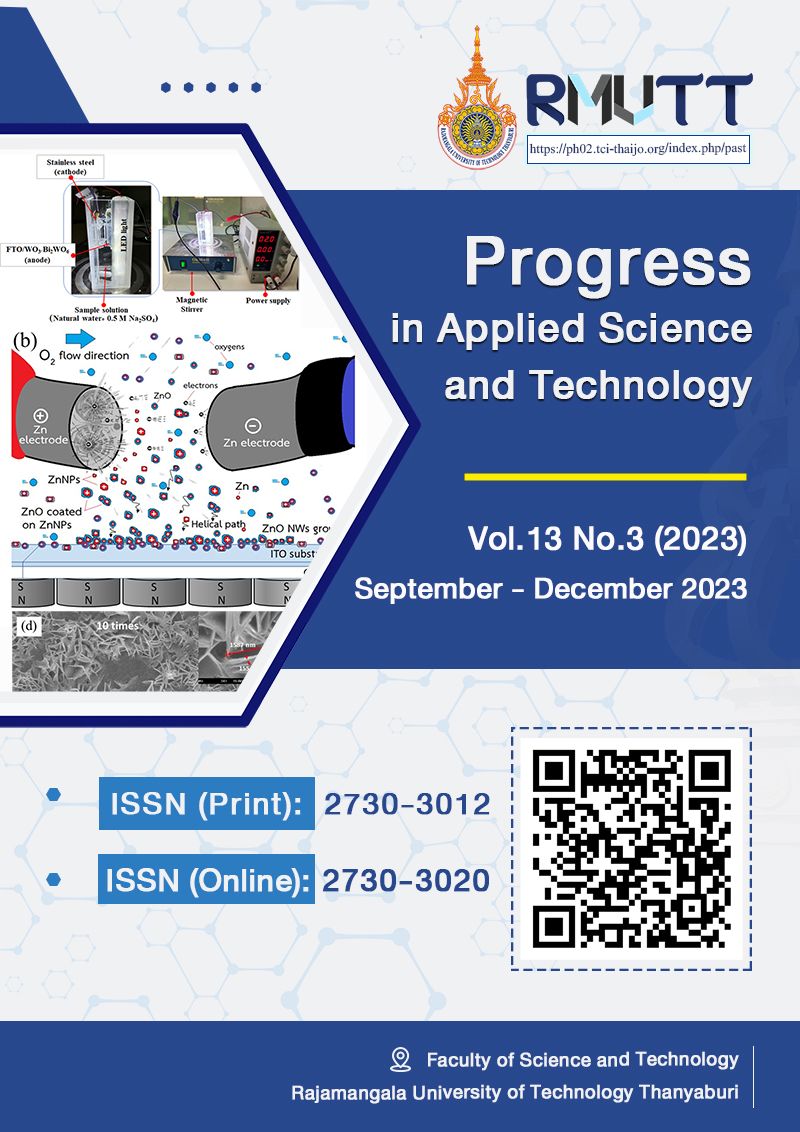Zinc Oxide Nanowall Networks Growth on Indium Tin Oxide Substrates in an Oxygen Atmosphere and Magnetic Field via the Sparking Process
Main Article Content
Abstract
A zinc oxide nanowall (ZnO NW) network was grown on an indium tin oxide (ITO) surface using the sparking process at a breakdown voltage. This process involved four pairs of pure zinc wire electrodes in a flowing oxygen atmosphere, with a perpendicular magnetic field applied downward onto the ITO surface. It was observed that the cluster number density of ZnO NWs on the ITO surface decreased with an increasing number of coatings. The transmittances of the glass/ITO/ZnO NW network substrate increased again once the nanostructure was completely formed and achieved higher crystallinity.
Article Details

This work is licensed under a Creative Commons Attribution-NonCommercial-NoDerivatives 4.0 International License.
References
Feng Z, Rafique S, Cai Y, Han L, Huang M-C, Zhao H. ZnO Nanowall Networks for Sensor Devices: From Hydrothermal Synthesis to Device Demonstration. ECS J Solid State Sci 2018;7(7):Q3114.
Bruno E, Strano V, Mirabella S, Donato N, Leonardi SG, Neri G. Comparison of the Sensing Properties of ZnO Nanowalls-Based Sensors toward Low Concentrations of CO and NO2. Chemosensors. 2017;5(3):20
Wang X, Ding Y, Li Z, Song J, Wang ZL. Single-Crystal Mesoporous ZnO Thin Films Composed of Nanowalls. J Phys Chem C. 2009;113(5):1791-4.
Yu L, Wei J, Luo Y, Tao Y, Lei M, Fan X, et al. Dependence of Al3+ on the growth mechanism of vertical standing ZnO nanowalls and their NO2 gas sensing properties. Sensors Actuators B: Chem. 2014;204:96-101.
Lin L, Jiang L, Li P, Fan B, Qiu Y. A modeled perovskite solar cell structure with a Cu2O hole-transporting layer enabling over 20% efficiency by low-cost low-temperature processing. J Phys Chem Solids. 2019;124:205-11.
Liang Z, Gao R, Lan J-L, Wiranwetchayan O, Zhang Q, Li C, et al. Growth of vertically aligned ZnO nanowalls for inverted polymer solar cells. Sol. Energy Mater Sol. Cells. 2013;117:34-40.
Saravanakumar B, Kim S-J. Growth of 2D ZnO Nanowall for Energy Harvesting Application. J Phys Chem C. 2014;118(17):8831-6.
Kim S-W, Fujita S, Yi M-S, Yoon DH. Catalyst-free synthesis of ZnO nanowall networks on Si3N4∕Si substrates by metalorganic chemical vapor deposition. Appl Phys Lett. 2006;88(25):253114.
Jiang B-C, Yang S-H. Nickel-Doped ZnO Nanowalls with Enhanced Electron Transport Ability for Electrochemical Water Splitting. Nanomater (Basel, Switzerland). 2021;11(8).
Jin C, Li J, Wang J, Han S, Wang Z, Sun Q. Cross-Linked ZnO Nanowalls Immobilized onto Bamboo Surface and Their Use as Recyclable Photocatalysts. Guo C, editor. J Nanomater. 2014;2014:687350.
Pellegrino D, Franzò G, Strano V, Mirabella S, Bruno E. Improved Synthesis of ZnO Nanowalls: Effects of Chemical Bath Deposition Time and Annealing Temperature. Vol. 7, Chemosensors. 2019.
Pradhan D, Sindhwani S, Leung KT. Parametric Study on Dimensional Control of ZnO Nanowalls and Nanowires by Electrochemical Deposition. Nanoscale Res Lett. 2010;5(11):1727-36.
Rafique S, Han L, Zhao H. Density Controlled Growth of ZnO Nanowall–Nanowire 3D Networks. J Phys Chem C. 2015;119(21):12023-9.
Wu CC, Wuu DS, Lin PR, Chen TN, Horng RH. Effects of Growth Conditions on Structural Properties of ZnO Nanostructures on Sapphire Substrate by Metal–Organic Chemical Vapor Deposition. Nanoscale Res Lett. 2009;4(4):377.
Tang J-F, Tseng Z-L, Chen L-C, Chu S-Y. ZnO nanowalls grown at low-temperature for electron collection in high-efficiency perovskite solar cells. Sol. Energy Mater Sol. Cells. 2016;154:18-22.
Jang E-S. Recent Progress in Synthesis of Plate-like ZnO and its Applications: A Review. J Korean Ceram Soc. 2017;54(3):167-83.
Ghai V, Sharma K, Sanger J, Singh H, Agnihotri PK. Ultrafast microwave-assisted synthesis of various zinc oxide nanostructures. Indian J Eng Mater Sci. 2020;27(Apr-2020):365.
Ručman S, Intra P, Kantarak E, Sroila W, Kumpika T, Jakmunee J, et al. Influence of the magnetic field on bandgap and chemical composition of zinc thin films prepared by sparking discharge process. Sci Rep. 2020;10(1):1388.
Thongsuwan W, Sroila W, Kumpika T, Kantarak E, Singjai P. Antireflective, photocatalytic, and superhydrophilic coating prepared by facile sparking process for photovoltaic panels. Sci Rep. 2022;12(1):1675.
Xiao S, Tian S, Cressault Y, Zhang X, Tang J, Li Y, et al. Study on the influence of O2 on the breakdown voltage and self-recovery characteristics of c-C4F8/N2 mixture. AIP Adv. 2018;8(8):85121.
ASTM G173-03 Reference Spectra Derived from SMARTS v. 2.9.2 [Internet]. [cited 2023 Aug 12].
Shichen S, Xiaodong Y, Candong H. Fabrication of ZnO nanowall-network ultraviolet photodetector on Si substrates. J Semicond. 2011;32(7):74008.
Wu W-Y, Ting J-M, Chang C-K. Morphology-selected, room-temperature growth of ZnO nanostructures. CrystEngComm. 2010;12(5):1433-8.
Wongsaeng C, Singjai P. Mobilities in ambipolar field effect transistors based on single-walled carbon nanotube network and formed on a gold nanoparticle template. Appl Phys Lett. 2014;104(14).
Chang Y-C, Lin Y-R, Chen S-W, Chou C-M. Density-Controlled Growth of ZnO Nanowalls for High-Performance Photocatalysts. Materials (Basel). 2022;15:9008.
Hornyak GL, Tibbals HF, Dutta J, Moore JJ. Introduction to Nanoscience & Nanotechnology. USA: CRC Press, Taylor & Francis Group, LLC; 2009. p. 1205.
Knight RD, Jones B, Field S. College Physics A Strategic Approach. USA: Pearson Addison-Wesley; 2007. p. 701.
Wongsaeng C. Synthesis and Electronic Analysis of Single-Walled Carbon Nanotube and Metal Nanoparticle Contacts. Chiang Mai University; 2013.
Xu Y, Yan X-T. Chemical Vapour Deposition An Integrated Engineering Design for Advanced Materials. Springer Verlag London Limited; 2010. p. 2.
Grove AS. Physics and Technology of Semiconductor Devices. USA: John Wiley & Sons, Inc.; 1967. p. 13.
Chen Q, Jiang C, Chen M, Zhang J, Hou G, Tang Y. Magnetic field stabilizes zinc anode. Surfaces and Interfaces. 2022;31:101972.






